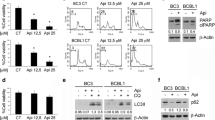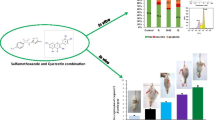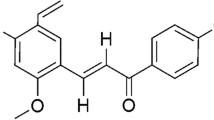Abstract
Cancer cells are characterized by increased production of reactive oxygen species (ROS) and an altered redox environment as compared to normal cells. Continuous accumulation of ROS triggers oxidative stress leading to hyper-activation of signaling pathways that promote cell proliferation, survival, and metabolic adaptation to the tumor microenvironment. Therefore, antioxidants are proposed to contribute to cancer prevention. Protein kinase C (PKC) is a crucial regulator of diverse cellular processes and contributes to cancer progression. The activation of PKC is partially dependent on ROS signaling. In the present study, cancer preventive activity of natural flavonoid quercetin is analyzed in ascite cells of Dalton’s lymphoma-bearing mice. The total ROS level and activity of PKC were downregulated after quercetin treatment in lymphoma-bearing mice. Quercetin modulates the expression of almost all isozymes of classical, novel, and atypical PKC as well as downregulates the level and expression of PKCα. Further, quercetin improves apoptotic potential, as observed by the levels of caspase 3, caspase 9, PARP, PKCδ, and nuclear condensation. Additionally, quercetin reduces cell survival and promotes death receptor-mediated apoptosis via differential localization of the TNFR1 level in ascite cells. The overall result suggests the cancer preventive activity of quercetin via the induction of apoptosis and modulates PKC signaling with the reduction of oxidative stress in ascite cells of lymphoma-bearing mice.








Similar content being viewed by others
References
Nogueira V, Hay N. Molecular pathways: reactive oxygen species homeostasis in cancer cells and implications for cancer therapy. Clin Cancer Res. 2013;19:4309–14.
Sosa V, Moliné T, Somoza R, Paciucci R, Kondoh H, LLeonart ME. Oxidative stress and cancer: an overview. Ageing Res Rev. 2013;12:376–90.
Valko M, Rhodes CJ, Moncol J, Izakovic M, Mazur M. Free radicals, metals and antioxidants in oxidative stress-induced cancer. Chem Biol Interact. 2006;160:1–40.
Ivanova D, Bakalova RLD, et al. The impact of reactive oxygen species. Clin Adv Med Exp. 2013;22:899–908.
Weinberg F, Chandel NS. Reactive oxygen species-dependent signaling regulates cancer. Cell Mol Life Sci. 2009;66:3663–73.
Naka K, Muraguchi T, Hoshii T, Hirao A. Regulation of reactive oxygen species and genomic stability in hematopoietic stem cells. Antioxid Redox Signal. 2008;10:1883–94.
Trachootham D, Alexandre J, Huang P. Targeting cancer cells by ROS-mediated mechanisms: a radical therapeutic approach. Nat Rev Drug Discov. 2009;8:579–91.
Coleman WB, Tsongalis GJ. Molecular mechanisms of human carcinogenesis. Cancer: cell structures, carcinogens and genomic instability. EXS. 2006;96:321–49.
Wu WS. The signaling mechanism of ROS in tumor progression. Cancer Metastasis Rev. 2006;25:695–705.
Gopalakrishna R, Gundimeda U. Antioxidant regulation of protein kinase C in cancer prevention. J Nutr. 2002;132:3819–23.
Trachootham D, Lu W, Ogasawara MA, Nilsa RDV, Huang P. Redox regulation of cell survival. Antioxid Redox Signal. 2008;10:1343–74.
Zhou F, Shen Q, Claret FX. Novel roles of reactive oxygen species in the pathogenesis of acute myeloid leukemia. J Leukoc Biol. 2013;94:423–9.
Saeidnia S, Abdollahi M. Antioxidants: friends or foe in prevention or treatment of cancer: the debate of the century. Toxicol Appl Pharmacol. 2013;271:49–63.
Samoylenko A, Hossain J, Mennerich D, Kellokumpu S, Hiltunen JK, Kietzmann T. Nutritional countermeasures targeting reactive oxygen species in cancer: from mechanisms to biomarkers and clinical evidence. Antioxid Redox Signal. 2013;19:2157–96.
Glasauer A, Chandel NS. Targeting antioxidants for cancer therapy. Biochem Pharmacol. 2014;92:90–101.
Hu CT, Wu JR, Cheng CC, Wang S, Wang HT, Lee MC, et al. Reactive oxygen species-mediated PKC and integrin signaling promotes tumor progression of human hepatoma HepG2. Clin Exp Metastasis. 2011;28:851–63.
Aspects D, Giorgi C, Agnoletto C, Baldini C, Bononi A, Bonora M, et al. Redox control of protein kinase C : cell-and disease-specific aspects. Antioxid Redox Signal. 2010;13:1051–85.
Paulsen CE, Carroll KS. Orchestrating redox signaling networks through regulatory cysteine switches. ACS Chem Biol. 2010;5:47–62.
Frey RS, Gao X, Javaid K, Siddiqui SS, Rahman A, Malik AB. Phosphatidylinositol 3-kinase gamma signaling through protein kinase Czeta induces NADPH oxidase-mediated oxidant generation and NF-kappaB activation in endothelial cells. J Biol Chem. 2006;281:16128–38.
Talior I, Tennenbaum T, Kuroki T, Eldar-Finkelman H. PKC-delta-dependent activation of oxidative stress in adipocytes of obese and insulin-resistant mice: role for NADPH oxidase. Am J Physiol Endocrinol Metab. 2005;288:405–11.
Caino MC, Meshki J, Kazanietz MG. Hallmarks for senescence in carcinogenesis: novel signaling players. Apoptosis. 2009;14:392–408.
Mishra S, Vinayak M. Anti-carcinogenic action of ellagic acid mediated via modulation of oxidative stress regulated genes in Dalton lymphoma bearing mice. Leuk Lymphoma. 2011;52:2155–61.
Lee SK, Shehzad A, Jung JC, Sonn JK, Lee JT, Park JW, et al. Protein kinase Cα protects against multidrug resistance in human colon cancer cells. Mol Cells. 2012;34:61–9.
Konopatskaya O, Poole AW. Protein kinase Calpha: disease regulator and therapeutic target. Trends Pharmacol Sci. 2010;31:8–14.
Wu TT, Hsieh YH, Hsieh YS, Liu JY. Reduction of PKC alpha decreases cell proliferation, migration, and invasion of human malignant hepatocellular carcinoma. J Cell Biochem. 2008;103:9–20.
Zhao M, Xia L, Chen GQ. Protein kinase cδ in apoptosis: a brief overview. Arch Immunol Ther Exp. 2012;60:361–72.
Reyland ME. Protein kinase C δ and apoptosis. Biochem Soc Trans. 2007;35:1001–4.
Ghayur BT, Hugunin M, Talanian RV, Ratnofsky S, Quinlan C, Emoto Y, et al. Proteolytic activation of protein kinase C δ by an ICE/CED 3-like protease induces characteristics of apoptosis. J Exp Med. 1996;184:2399–404.
Kanthasamy AG, Kitazawa M, Yang Y, Anantharam V, Kanthasamy A. Environmental neurotoxin dieldrin induces apoptosis via caspase-3-dependent proteolytic activation of protein kinase C delta (PKCdelta): implications for neurodegeneration in Parkinson’ s disease. Mol Brain. 2008;12:1–15. doi:10.1186/1756-6606-1-12.
Oh J, Chun K, Joo S, Oh Y, Lee S. Caspase-3-dependent protein kinase C delta activity is required for the progression of Ginsenoside-Rh2-induced apoptosis in SK-HEP-1 cells. Cancer Lett. 2005;230:228–38.
Thorburn A. Death receptor-induced cell killing. Cell Signal. 2004;16:139–44.
Pobezinskaya YL, Liu Z. The role of TRADD in death receptor signaling. Cell Cycle. 2012;11:871–6.
Baud V, Karin M. Signal transduction by tumor necrosis factor and its relatives. Trends Cell Biol. 2001;11:372–7.
Tracey D, Klareskog L, Sasso EH, Salfeld JG, Tak PP. Tumor necrosis factor antagonist mechanisms of action: a comprehensive review. Pharmacol Ther. 2008;117:244–79.
Wajant H, Scheurich P. TNFR1-induced activation of the classical NF-κB pathway. FEBS J. 2011;278:862–76.
Maurya AK and Vinayak M. Quercetin regresses Dalton’s lymphoma growth via suppression of PI3K/AKT signaling leading to up regulation of p53 and decrease in energy metabolism. Nutr Cancer. 2014;67:354–63.
Hayashi A. Effects of daily oral administration of quercetin chalcone and modified citrus pectin on implanted colon-25 tumor growth in Balb-c mice. Altern Med Rev. 2006;5:546–52.
Goldie H, Dingman FM. Growth characteristics of free tumor cells transferred serially in the peritoneal fluid of the mouse. Cancer Res. 1951;11:73–80.
Aita K, Irie H, Tanuma Y, Toida S, Okuma Y, Mori S, et al. Apoptosis in murine lymphoid organs following intraperitoneal administration of dimethyl sulfoxide (DMSO). Exp Mol Pathol. 2005;79:265–71.
Chen N, Ma WY, Huang C, Dong Z. Translocation of protein kinase C and protein kinase C to membrane is required for ultraviolet B-induced activation of mitogen-activated protein kinases and apoptosis. J Biol Chem. 1999;274:15389–94.
Qian W, Nishikawa M, Haque AM, Hirose M, Mashimo M, Sato E, et al. Mitochondrial density determines the cellular sensitivity to cisplatin-induced cell death. Am J Physiol Cell Physiol. 2005;289:C1466–75.
Ribble D, Goldstein NB, Norris DA, Shellman YG. A simple technique for quantifying apoptosis in 96-well plates. BMC Biotechnol. 2005;7:1–7.
Das L, Vinayak M. Long term effect of curcumin in regulation of glycolytic pathway and angiogenesis via modulation of stress activated genes in prevention of cancer. PLoS ONE. 2014;9:1–12.
Mishra S, Vinayak M. Ellagic acid induces novel and atypical PKC isoforms and promotes caspase-3 dependent apoptosis by blocking energy metabolism. Nutr Cancer. 2014;66:675–81.
Elmore S. Apoptosis: a review of programmed cell death. Toxicol Pathol. 2007;35:495–516.
Gutcher I, Webb PR, Anderson NG. The isoform-specific regulation of apoptosis by protein kinase C. Cell Mol Life Sci. 2003;60:1061–70.
Mauro A. PKCalpha-mediated ERK, JNK and p38 activation regulates the myogenic program in human rhabdomyosarcoma cells. J Cell Sci. 2002;115:3587–99.
Martiny-Baron G, Fabbro D. Classical PKC isoforms in cancer. Pharmacol Res. 2007;55:477–86.
Lahn M, Sundell K, Gleave M, Ladan F, Su C, Li S, et al. Protein kinase C-α in prostate cancer. BJU Int. 2004;93:1076–81.
Zhang XM, Chen J, Xia YG, Xu Q. Apoptosis of murine melanoma B16-BL6 cells induced by quercetin targeting mitochondria, inhibiting expression of PKC-alpha and translocating PKC-delta. Cancer Chemother Pharmacol. 2005;55:251–62.
Gamet-Payrastre L, Manenti S, Gratacap M-P, Tulliez J, Chap H, Payrastre B. Flavonoids and the inhibition of PKC and PI 3-kinase. Gen Pharmacol Vasc Syst. 1999;32:279–86.
Granado-serrano AB, Martín MA, Bravo L, Goya L. Time-course regulation of quercetin on cell survival / proliferation pathways in human hepatoma cells. Mol Nutr Food Res. 2008;52:457–64.
Wu CH, Wu CF, Huang HW, Jao YC, Yen GC. Naturally occurring flavonoids attenuate high glucose-induced expression of proinflammatory cytokines in human monocytic THP-1 cells. Mol Nutr Food Res. 2009;53:984–95.
Ruvolo PP, Deng X, Carr BK, May WS, Biol WSJ, Reh H. A functional role for mitochondrial protein kinase Cα in Bcl2 phosphorylation and suppression of apoptosis. J Biol Chem. 1998;273:25436–42.
Popla YG, Murray NR, Velasco MA, Gatalica Z, Fields AP. Elevated protein kinase CβII is an early promotive event in colon carcinogenesis. Cancer Res. 2001;2:1375–81.
Kawakami Y, Nishimoto H, Kitaura J, Maeda-Yamamoto M, Kato RM, Littman DR, et al. Protein kinase C betaII regulates Akt phosphorylation on Ser-473 in a cell type- and stimulus-specific fashion. J Biol Chem. 2004;279:47720–5.
Numazawa S, Ishikawa M, Yoshida A, Tanaka S, Yoshida T. Atypical protein kinase C mediates activation of NF-E2-related factor 2 in response to oxidative stress. Am J Physiol Cell Physiol. 2003;285:334–42.
Kim JH, Kim JH, Ohba M, Suh PG, Ryu SH. Novel functions of the phospholipase D2-Phox homology domain in protein kinase Czeta activation. Mol Cell Biol. 2005;25:3194–208.
Chen G, Goeddel DV. TNF-R1 signaling: a beautiful pathway. Science. 2002;296:1634–5.
Micheau O, Boveresses C, Epalinges C. Induction of TNF receptor I-mediated apoptosis via two sequential signaling complexes. Cell. 2003;114:181–90.
Liu Z, Hsu H, Goeddel DV, Karin M. Dissection of TNF receptor 1 effector functions: JNK activation is not linked to apoptosis while NF-κB activation prevents cell death. Cell. 1996;87:565–76.
D’Alessio A, Kluger MS, Li JH, Al-Lamki R, Bradley JR, Pober JS. Targeting of tumor necrosis factor receptor 1 to low density plasma membrane domains in human endothelial cells. J Biol Chem. 2010;285:23868–79.
Rivas MA, Carnevale RP, Proietti CJ, Rosemblit C, et al. TNF α acting on TNFR1 promotes breast cancer growth via p42/p44 MAPK, JNK, Akt and NF-kB-dependant pathways. Exp Cell Res. 2008;314:509–29.
Guicciardi ME, Gores GJ. Life and death by death receptors. FASEB J. 2009;23:1625–37.
Brachert WS, Tchikov V, Neumeyer J, Jakob M, Morbach SW, Feindt JF, et al. Compartmentalization of TNF receptor 1 signaling: internalized TNF receptosomes as death signaling vesicles. Immunity. 2004;21:415–28.
Pan HC, Jiang Q, Yu Y, Mei JP, Cui YK, Zhao WJ. Quercetin promotes cell apoptosis and inhibits the expression of MMP-9 and fibronectin via the AKT and ERK signalling pathways in human glioma cells. Neurochem Int. 2015;80:60–71.
Basu A, Woolard MD, Johnson CL. Involvement of protein kinase C-delta in DNA damage-induced apoptosis. Cell Death Differ. 2001;8:899–908.
Hazeki K, Inoue K, Nigorikawa K, Hazeki O. Negative regulation of class IA phosphoinositide 3-kinase by protein kinase Cdelta limits Fcgamma receptor-mediated phagocytosis in macrophages. J Biochem. 2009;145:87–94.
Acknowledgments
The research was supported by University Grants Commission (UGC), India. AKM thanks the Council of Scientific and Industrial Research (CSIR), India, for Senior Research Fellowship (CSIR Award No. File No: 09/013(0338)/2010-EMR-I).
Conflicts of interest
None
Author information
Authors and Affiliations
Corresponding author
Rights and permissions
About this article
Cite this article
Maurya, A.K., Vinayak, M. Modulation of PKC signaling and induction of apoptosis through suppression of reactive oxygen species and tumor necrosis factor receptor 1 (TNFR1): key role of quercetin in cancer prevention. Tumor Biol. 36, 8913–8924 (2015). https://doi.org/10.1007/s13277-015-3634-5
Received:
Accepted:
Published:
Issue Date:
DOI: https://doi.org/10.1007/s13277-015-3634-5




